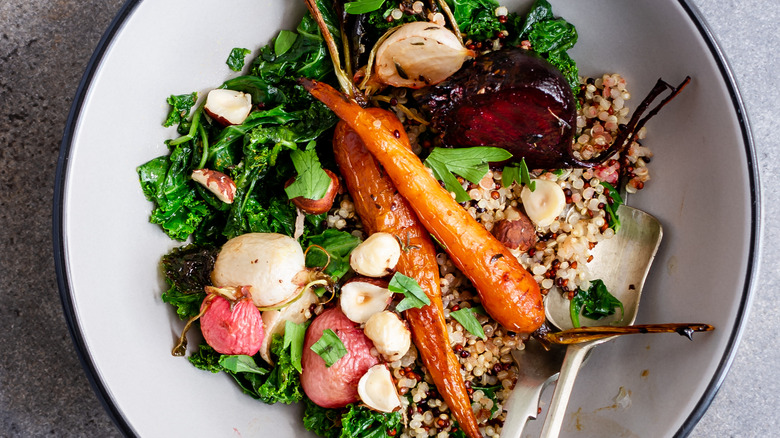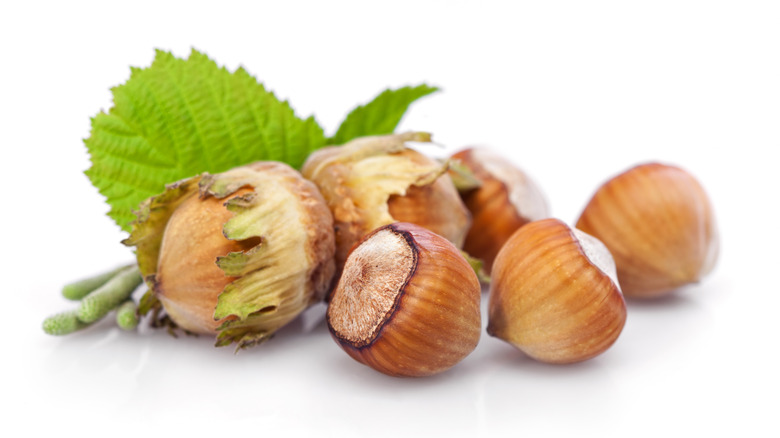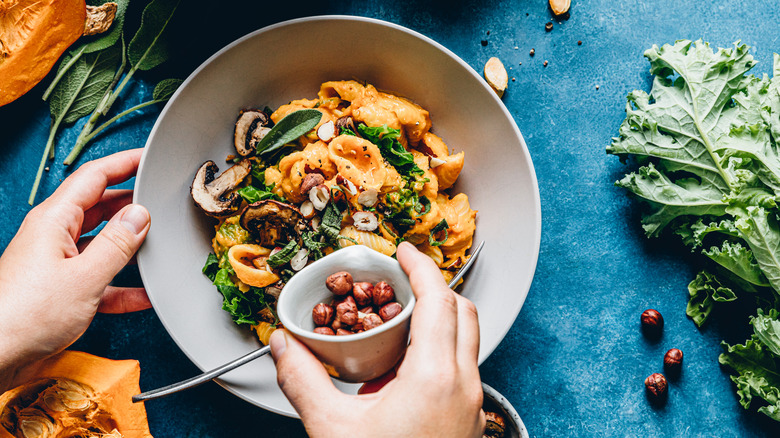Hazelnuts Are The Crunchy Ingredient Your Fall Roasted Veggies Need
From hearty soups to decadent pies, fall flavors can make for happy tastebuds. As the holiday season approaches, there's no better time to try adventurous new recipes that reflect autumn's crisp, nostalgic air. A platter of classic roasted vegetables can complete a fall feast, and almost any vegetable assortment can benefit from a hazelnut topping.
Whether you know them as hazelnuts, cobnuts, or filberts, these nuts are usually harvested in September and October, making them a quintessential fall food. They boast a rich, nutty essence that complements the earthy sweetness of roasted vegetables, giving each bite a more dynamic and exciting fall flavor. Hazelnuts bring a pleasant crunch to the dish, which creates a pleasing contrast with the softer texture of the roasted vegetables.
It's not just the flavor and texture of your roasted vegetable medley that hazelnuts can enhance. Incorporating these toasty little nuts into your favorite oven-roasted vegetable recipe adds a sophisticated visual flair as well as being a nutritious and edible garnish.
Hazelnut basics
Hazelnuts are not typically as common as better-known nuts such as walnuts, pecans, or almonds. Although you may have enjoyed a hazelnut latte, spread a creamy blend of chocolate and hazelnuts on fruit or bagels, or dipped into a carton of hazelnut ice cream, you may not be familiar with the hazelnut itself.
Hazelnuts are the aptly named nuts of the hazel tree, which are found across Italy, Greece, Spain, Turkey, and the United States. They're commonly processed into spreadable nut butter, used as a flavoring agent in coffee syrups and liqueurs, ground into gluten-free hazelnut flour, and as a crunchy accompaniment to a fall salad. Once the shell has been cracked and removed, hazelnuts can be eaten raw, but when they're roasted, they take on a sweeter, less bitter flavor, which makes them ideal for including in your fall vegetable roasts.
Hazelnuts are a nutrient-dense food that are excellent sources of vitamin E, healthy fats, and fiber. Including them in your diet can improve digestion, lower cholesterol, reduce inflammation, and support heart health, according to Medical News Today. Like most nuts, hazelnuts are also high in protein, which adds extra nutritional power to an otherwise low-protein batch of roasted vegetables.
Hazelnuts aren't a high-demand nut, so they might be tricky to find. However, you can often find hazelnuts in the baking aisle, or alongside other chopped and whole nuts, at your local supermarket. And of course, there's always online shopping.
Complementary pairings and tips
Not sure how to include hazelnuts with your roasted vegetables? Consider these complementary pairings and simple hacks when adding these tasty nuts to your next veggie roast.
Brussels sprouts, asparagus, and green beans benefit from hazelnuts' delicate, nutty crunch as a balance to their tender, savory profiles. Roasted carrots and butternut squash are other classic fall vegetables that can come alive when paired with the toasty taste of roasted hazelnuts. You can also add chopped hazelnuts to mushroom roasts and combine them with farro grains for a well-rounded and nutritious veggie-roast-turned meal.
Drizzles of citrus can add a zesty tang to the folksy flavor of hazelnut-kissed vegetables, while sweet syrupy ingredients like honey, agave nectar, or even maple syrup can bring a candied, caramelized glaze to the dish that balances the earthy taste of hazelnuts and roasted vegetables. Don't forget your aromatics — seasonings like cardamom, clove, and nutmeg can boost the fall spirit of hazelnut-topped vegetable roasts.


